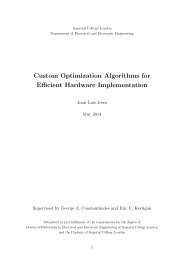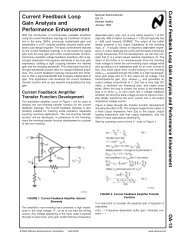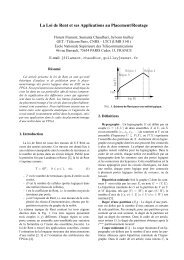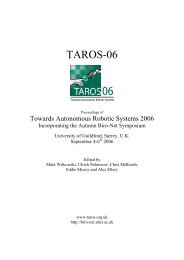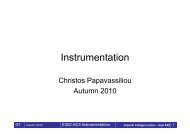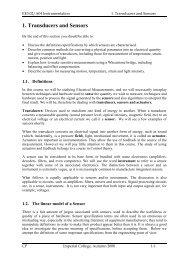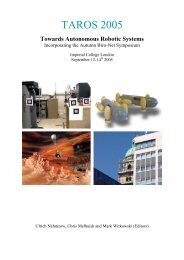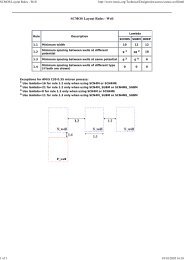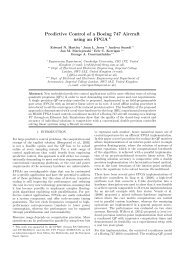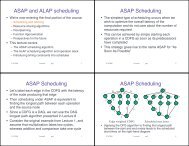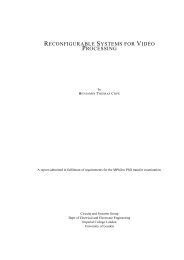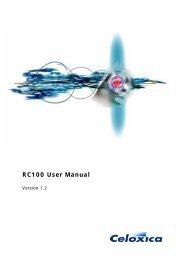E2.2 Analogue Electronics - EEE-CAS Home - Imperial College ...
E2.2 Analogue Electronics - EEE-CAS Home - Imperial College ...
E2.2 Analogue Electronics - EEE-CAS Home - Imperial College ...
You also want an ePaper? Increase the reach of your titles
YUMPU automatically turns print PDFs into web optimized ePapers that Google loves.
<strong>E2.2</strong> <strong>Analogue</strong> <strong>Electronics</strong><br />
• Instructor : Christos Papavassiliou<br />
• Office, email : EE 915, c.papavas@imperial.ac.uk<br />
• Lectures : Monday 2pm, room 408 (weeks 2-11)<br />
• Problem, Quizzes:<br />
Thursday 3pm, room 509 (weeks 4-11)<br />
Thursday 4pm, room 408 (weeks 3-4, 7-11)<br />
• Office hours: Tuesday 11am<br />
Thursday 10 am<br />
• Office hours start week 3 (week of 1910/09)<br />
• Course website: on blackboard<br />
(or on my home page)<br />
L1 Autumn 2009 <strong>E2.2</strong> <strong>Analogue</strong> <strong>Electronics</strong><br />
<strong>Imperial</strong> <strong>College</strong> London – <strong>EEE</strong> 1
What analogue electronics is<br />
• Engineering, i.e. the analysis (study and reverse engineering) and<br />
synthesis (“design”) of circuits:<br />
– Amplifiers, Filters, Oscillators<br />
– Radio<br />
– Multipliers (Modulators – Demodulators)<br />
– <strong>Analogue</strong> signal processing (e.g. rectifiers, logarithmic amplifiers)<br />
– Fast Digital gates (!)<br />
• Applications:<br />
Communications, Signal Processing, Control, Instrumentation, …<br />
• Areas of human activity:<br />
Industrial, Consumer, Biomedical, …<br />
L1 Autumn 2009 <strong>E2.2</strong> <strong>Analogue</strong> <strong>Electronics</strong><br />
<strong>Imperial</strong> <strong>College</strong> London – <strong>EEE</strong> 2
analogue electronics is not only<br />
• CMOS integrated circuits<br />
• Transistor circuits<br />
• Op-amp circuits<br />
• Audio electronics<br />
• Mobile phone circuits<br />
• Radars<br />
• Printed circuit board design<br />
• Integrated circuit design<br />
• Television set repair<br />
In fact, it is all of the above, and much more. Restricting our point of<br />
view to one of these will make understanding the topic more difficult.<br />
L1 Autumn 2009 <strong>E2.2</strong> <strong>Analogue</strong> <strong>Electronics</strong><br />
<strong>Imperial</strong> <strong>College</strong> London – <strong>EEE</strong> 3
Course Aims<br />
Learn to analyse electronic circuits<br />
•Analysis is prerequisite to:<br />
– DESIGN (including Integrated Circuit design)<br />
– APPLICATION (including repair)<br />
•Analysis is performed through modelling:<br />
– ABSTRACTION: replace groups of components with one symbol<br />
– SIMPLIFICATION but NOT oversimplification<br />
– MATHEMATICS (is a language, not a torture device!)<br />
•The inverse of ANALYSIS is SYNTHESIS (i.e. DESIGN!)<br />
•The course is closely connected to two other 2 nd year courses:<br />
– Control Theory<br />
– Signal processing<br />
because circuits are used to implement control and signal processing<br />
AND because without their methods circuit analysis is not possible (except in<br />
trivial cases)<br />
L1 Autumn 2009 <strong>E2.2</strong> <strong>Analogue</strong> <strong>Electronics</strong><br />
<strong>Imperial</strong> <strong>College</strong> London – <strong>EEE</strong> 4
L1 Autumn 2009 <strong>E2.2</strong> <strong>Analogue</strong> <strong>Electronics</strong><br />
<strong>Imperial</strong> <strong>College</strong> London – <strong>EEE</strong> 5
L1 Autumn 2009 <strong>E2.2</strong> <strong>Analogue</strong> <strong>Electronics</strong><br />
<strong>Imperial</strong> <strong>College</strong> London – <strong>EEE</strong> 6
Prerequisites<br />
• Analysis of circuits:<br />
– Kirchhoff's laws,Nodal Analysis,Thevenin and Norton Theorems,<br />
Phasors, Frequency and step Response of RC circuits, DC opamp<br />
circuits: Inverting and Non-Inverting Amplifiers.<br />
• <strong>Analogue</strong> electronics:<br />
– Static I-V characteristics of BJT and FET transistors<br />
– Small signal models of BJT and FET transistors<br />
– Single Stage Transistor amplifiers with BJT, FET<br />
• Maths:<br />
– Differentiation, Integration<br />
– Second order Ordinary differential Equations<br />
– Complex numbers<br />
– Fourier transforms<br />
L1 Autumn 2009 <strong>E2.2</strong> <strong>Analogue</strong> <strong>Electronics</strong><br />
<strong>Imperial</strong> <strong>College</strong> London – <strong>EEE</strong> 7
• These slides<br />
References<br />
• Main Course text:<br />
– Sergio Franco: Design with Operational Amplifiers and Analog<br />
Integrated Circuits, McGraw Hill<br />
• Any book in analogue electronics you like. There are many! e.g.<br />
– Sedra and Smith, Microelectronic Circuits, Oxford U. Press<br />
• The best general reference in electronics (but not the best to learn from):<br />
– Horowitz and Hill, The Art of <strong>Electronics</strong>, Cambridge U. Press.<br />
L1 Autumn 2009 <strong>E2.2</strong> <strong>Analogue</strong> <strong>Electronics</strong><br />
<strong>Imperial</strong> <strong>College</strong> London – <strong>EEE</strong> 8
Workload<br />
Direct workload:<br />
• 17 lectures<br />
• 8 problem sessions starting on week 3<br />
• 1 problem sheet/week<br />
Assessment:<br />
• final exam : 2 hours long (100% of the marks)<br />
Indirectly related lab work<br />
L1 Autumn 2009 <strong>E2.2</strong> <strong>Analogue</strong> <strong>Electronics</strong><br />
<strong>Imperial</strong> <strong>College</strong> London – <strong>EEE</strong> 9
The “tools of the trade”<br />
• Kirchhoff's Current Law (KCL) � “nodal analysis”<br />
• Kirchhoff's Voltage Law (KVL) � “mesh analysis” (difficult!)<br />
• Ohm’s Law � Idealised Resistors and conductors<br />
• Phasor analysis (i.e. Fourier transform): Capacitors, Inductors<br />
• Modeling:<br />
– large signal analysis<br />
– small signal analysis<br />
• Approximations:<br />
– Thevenin and Norton “Theorems”<br />
• Bode Plots<br />
• All of the above, and more, is implemented in simulators: eg. SPICE<br />
• Mathematics!<br />
L1 Autumn 2009 <strong>E2.2</strong> <strong>Analogue</strong> <strong>Electronics</strong><br />
<strong>Imperial</strong> <strong>College</strong> London – <strong>EEE</strong> 10
Circuit Components<br />
• Independent Sources<br />
– Voltage, Current<br />
• Dependent Sources<br />
– Voltage Controlled (Voltage, Current) Source: VCVS and VCCS<br />
– Current Controlled (Voltage, Current) Source: CCVS and CCCS<br />
• Resistors<br />
• Capacitors, Inductors, transformers<br />
• Diodes,<br />
• Transistors<br />
– Bipolar Junction (BJT): NPN, PNP<br />
– Field Effect (FET): n-channel, p-channel, JFET, MOSFET…<br />
• Operational amplifiers<br />
L1 Autumn 2009 <strong>E2.2</strong> <strong>Analogue</strong> <strong>Electronics</strong><br />
<strong>Imperial</strong> <strong>College</strong> London – <strong>EEE</strong> 11
Computer simulation: SPICE<br />
• Written at the University of California – Berkeley<br />
• User inputs netlist, ie a list of components connecting nodes<br />
– The netlist is a way of writing the admittance matrix !<br />
– Schematic capture is a GUI producing netlists<br />
• User specifies one or more types of analysis to be performed:<br />
– DC bias<br />
– AC small signal<br />
– Transient<br />
– Component sensitivity<br />
• Commercial versions: very expensive, confusingly complicated!<br />
• Free packages (with schematic, on the web; grab one!):<br />
– 5Spice: http://www.5spice.com (schematic capture, includes WinSpice)<br />
– SIMetrix: www.catena.uk.com/ (complete package)<br />
– LT Spice : http://www.linear.com/designtools/software/switchercad.jsp<br />
History of SPICE: http://www.ecircuitcenter.com/SpiceTopics/History.htm<br />
L1 Autumn 2009 <strong>E2.2</strong> <strong>Analogue</strong> <strong>Electronics</strong><br />
<strong>Imperial</strong> <strong>College</strong> London – <strong>EEE</strong> 12
Resistors, Conductors, Capacitors, Inductors<br />
• Ohm’s law can be written in two ways:<br />
• Clearly R=1/G<br />
• This is useful in simplifying circuits:<br />
– Resistors in series: Rtotal = R1+ R2<br />
R1R2 – Resistors in parallel: G NOT:<br />
total = G1+ G R<br />
2<br />
total =<br />
R<br />
• Some standard terminology:<br />
1+ R2<br />
– Impedance Z: Z = R+ jX (R: Resistance, X: Reactance)<br />
– Admittance Y: Y = G+ jB (G: Conductance, B: Susceptance)<br />
– Immitance: Impedance and Admittace considered together<br />
• Note that:<br />
– Capacitor: BC= ωC;<br />
The capacitor is naturally a susceptor<br />
– Inductor: XL= ωL;<br />
The inductor is naturally a reactor<br />
• Nodal analysis is easier if we treat components as admittances<br />
�Nodal equations and the admittance matrix<br />
L1 Autumn 2009 <strong>E2.2</strong> <strong>Analogue</strong> <strong>Electronics</strong><br />
V = IR , I = GV<br />
<strong>Imperial</strong> <strong>College</strong> London – <strong>EEE</strong> 13
Any part of a circuit with 2 external terminals can be replaced by a Thevenin<br />
equivalent circuit.<br />
• Entire networks with 2 terminals can considered to be a single component<br />
• The Thevenin voltage source may be a:<br />
• Fixed voltage source<br />
• Voltage controlled voltage source<br />
• Current controlled voltage source<br />
• Note that V L =V T Z L / (Z T + Z L )<br />
• In real life, Z T is never zero !<br />
The Thevenin Theorem<br />
•The Thevenin theorem is a Taylor expansion of V(I) about the operating<br />
point V 0 , I 0 (if the expansion exists!)<br />
L1 Autumn 2009 <strong>E2.2</strong> <strong>Analogue</strong> <strong>Electronics</strong><br />
<strong>Imperial</strong> <strong>College</strong> London – <strong>EEE</strong> 14
The Norton Theorem<br />
Any part of a circuit with 2 external terminals can be replaced by a Norton<br />
equivalent circuit.<br />
• Entire networks with 2 terminals can considered to be a single component<br />
• The Norton current source may be a:<br />
• Fixed current source<br />
• Voltage controlled current source<br />
• Current controlled current source<br />
• Note that I L =I N Y N / (Y N + Y L )<br />
• In real life, Y N is never zero !<br />
•The Norton theorem is a Taylor expansion of I(V) about the operating point<br />
V 0 , I 0 (if the expansion exists!)<br />
L1 Autumn 2009 <strong>E2.2</strong> <strong>Analogue</strong> <strong>Electronics</strong><br />
<strong>Imperial</strong> <strong>College</strong> London – <strong>EEE</strong> 15
Thevenin and Norton special cases<br />
A Thevenin equivalent circuit with:<br />
• zero Thevenin impedance is an ideal voltage source<br />
• infinite Thevenin impedance is an ideal current source<br />
� If the magnitude of the Thevenin impedance is larger than the<br />
magnitude of the load impedance connected to it we usually prefer to<br />
model the component using a Norton equivalent circuit<br />
•A Norton equivalent circuit with:<br />
• zero Norton admittance is an ideal current source<br />
• infinite Norton admittance is an ideal voltage source<br />
� If the magnitude of the Norton admittance is larger than the<br />
magnitude of the load admittance connected to it we usually prefer to<br />
model the component using a Thevenin equivalent circuit<br />
L1 Autumn 2009 <strong>E2.2</strong> <strong>Analogue</strong> <strong>Electronics</strong><br />
<strong>Imperial</strong> <strong>College</strong> London – <strong>EEE</strong> 16
The Thevenin equivalent of a voltage divider<br />
• Think of the series element as an impedance Z(s)<br />
• Think of the shunt element as an admittance T(s)<br />
• Both Z and Y are arbitrary functions of frequency s=jw<br />
• Thevenin voltage is the value of the voltage divider:<br />
V IN<br />
Z(s)<br />
• Thevenin impedance is the parallel combination of Z an Y:<br />
Z<br />
T<br />
• These forms are easy to remember!<br />
L1 Autumn 2009 <strong>E2.2</strong> <strong>Analogue</strong> <strong>Electronics</strong><br />
V T<br />
Z T<br />
V<br />
= +<br />
V<br />
IN<br />
T<br />
Y(s) 1 Z ( sY ) ( s)<br />
( )<br />
( ) ( )<br />
V ⎛ oc V ⎞ V Z s<br />
= = ⎜ ⎟ =<br />
Isc ⎝1+ Z( s) Y( s) ⎠ Z( s)<br />
1+<br />
Z s Y s<br />
<strong>Imperial</strong> <strong>College</strong> London – <strong>EEE</strong> 17
L1 L2 L3 Ln<br />
C1 C2<br />
Cn<br />
(a)<br />
Ladder networks<br />
First Cauer form Second Cauer form<br />
L1 Autumn 2009 <strong>E2.2</strong> <strong>Analogue</strong> <strong>Electronics</strong><br />
C1<br />
L1<br />
C2 C3<br />
L2<br />
When they are made of L and C they are called “canonical filters” or<br />
“Cauer forms”. They are the most efficient filter implementations.<br />
•Start from left<br />
• do a sequence of Thevenin and Norton transformations<br />
• NEVER do nodal analysis<br />
• if components are RLC both the Thevenin voltage and Thevenin<br />
impedance are ratios of polynomials in frequency<br />
(b)<br />
Cn<br />
Ln<br />
<strong>Imperial</strong> <strong>College</strong> London – <strong>EEE</strong> 18
Large Signal<br />
I SC =I N<br />
I<br />
Small Signal and Large Signal models<br />
V OC =V T<br />
G N =1/R T<br />
Model is secant on the IV curve Model is tangent on the IV curve<br />
The following relations are always valid:<br />
R = 1/ G<br />
V = I R<br />
T N<br />
T N T<br />
• Most circuits (except of ideal sources) have both Thevenin and Norton equivalents<br />
• Unless we say otherwise, we are only concerned with small signal equiv. circuits.<br />
L1 Autumn 2009 <strong>E2.2</strong> <strong>Analogue</strong> <strong>Electronics</strong><br />
V<br />
Small Signal:<br />
I SC =I N<br />
I<br />
V OC =V T<br />
G N =1/R T<br />
V<br />
<strong>Imperial</strong> <strong>College</strong> London – <strong>EEE</strong> 19



